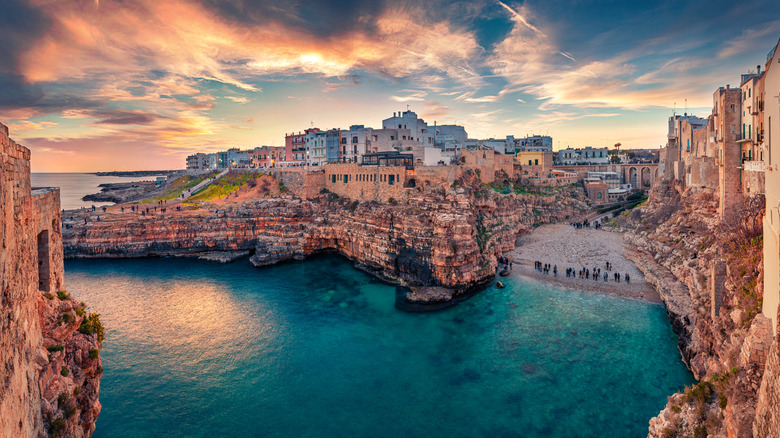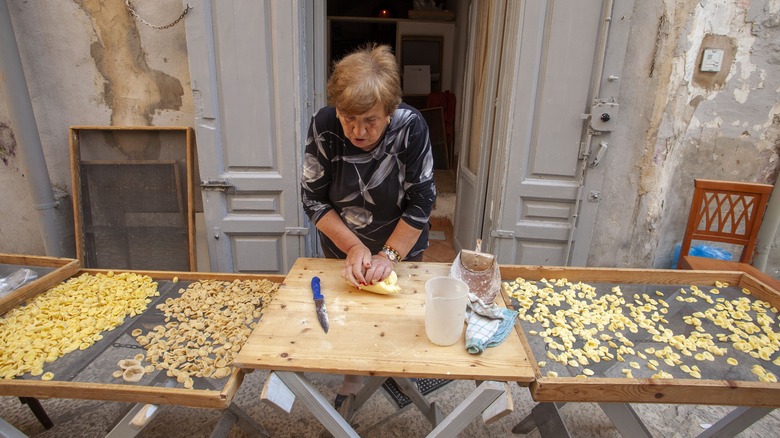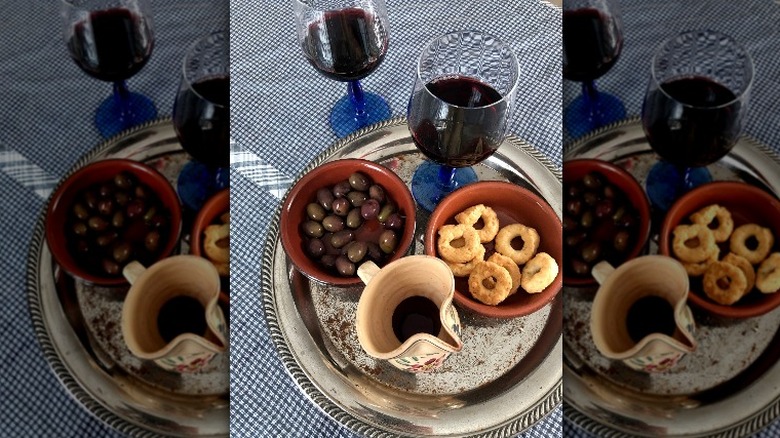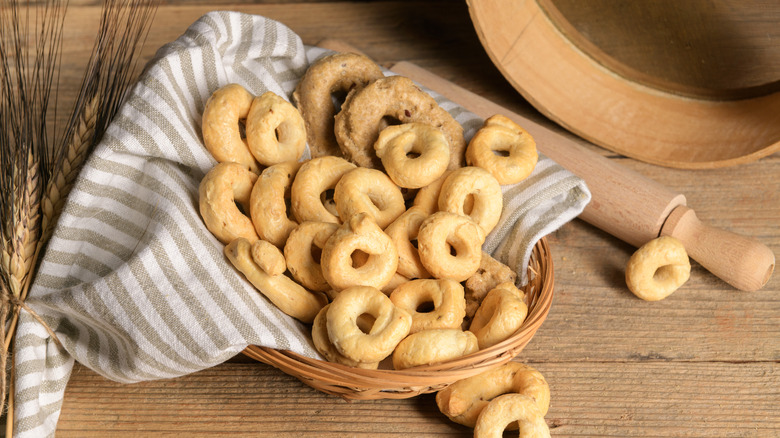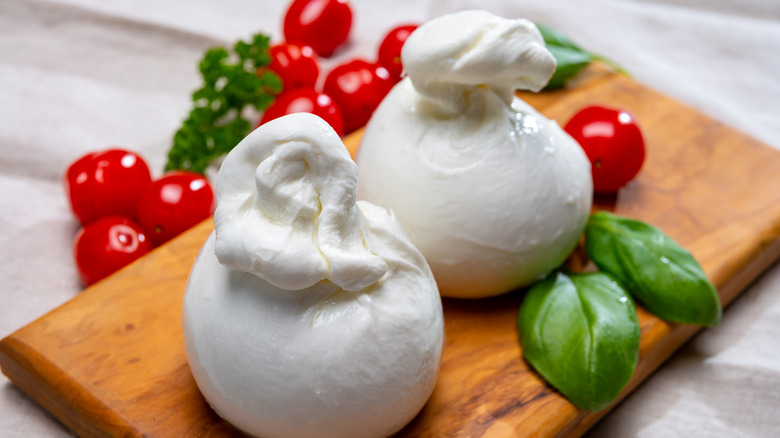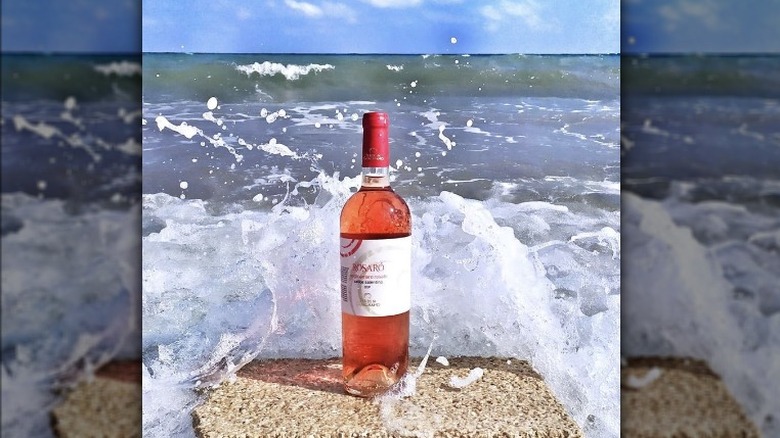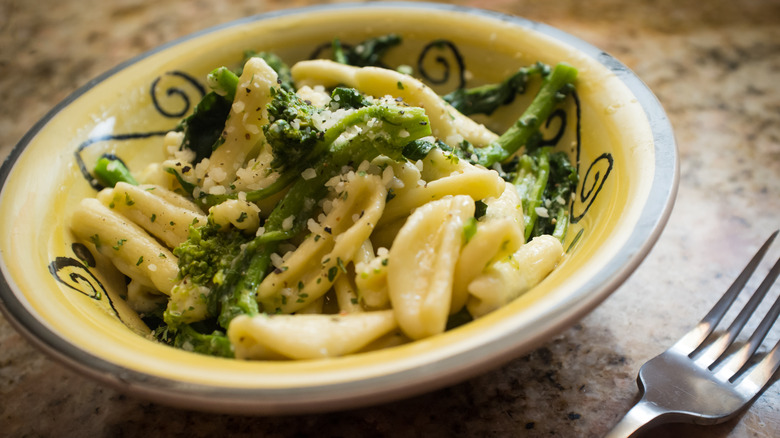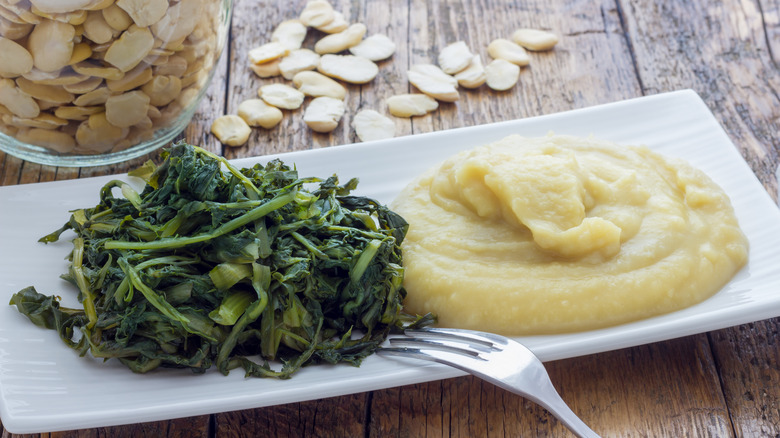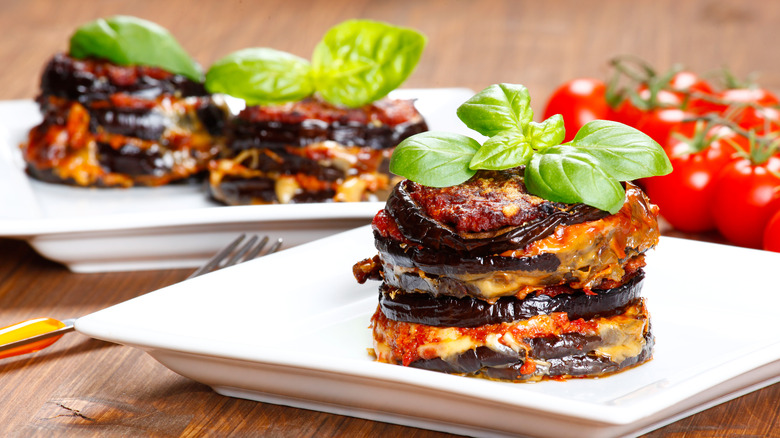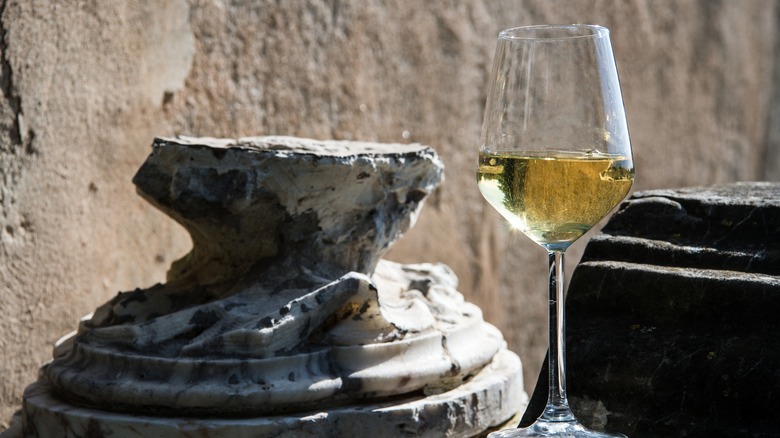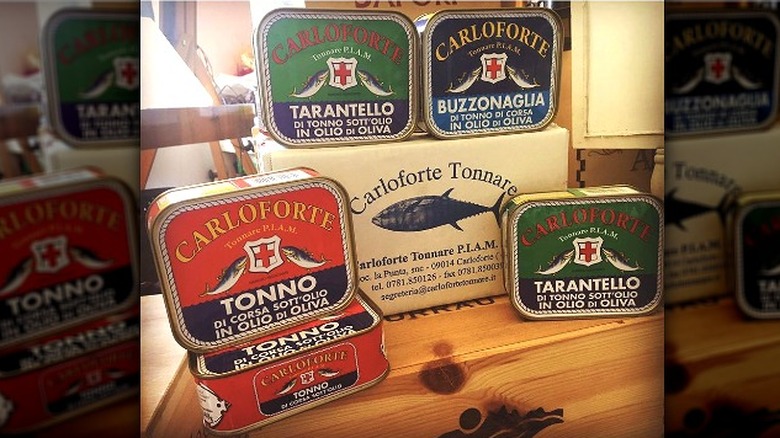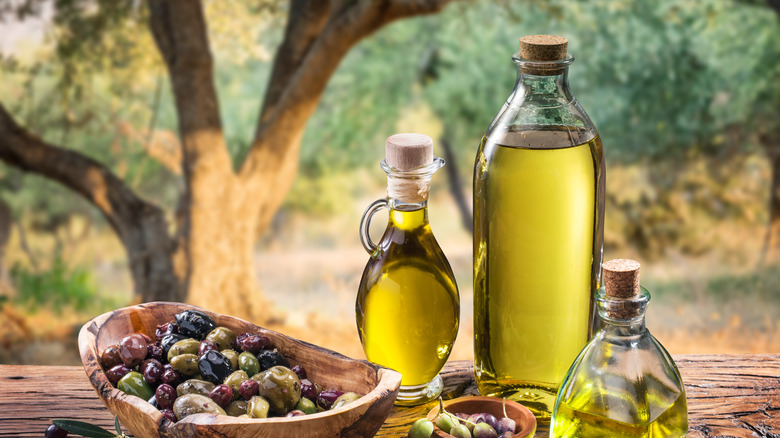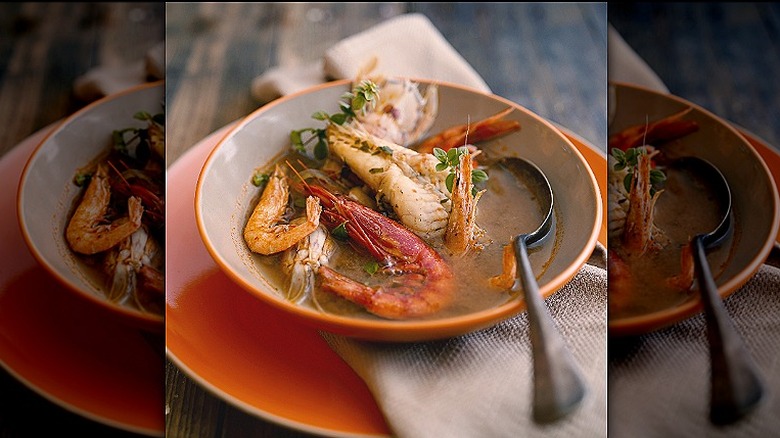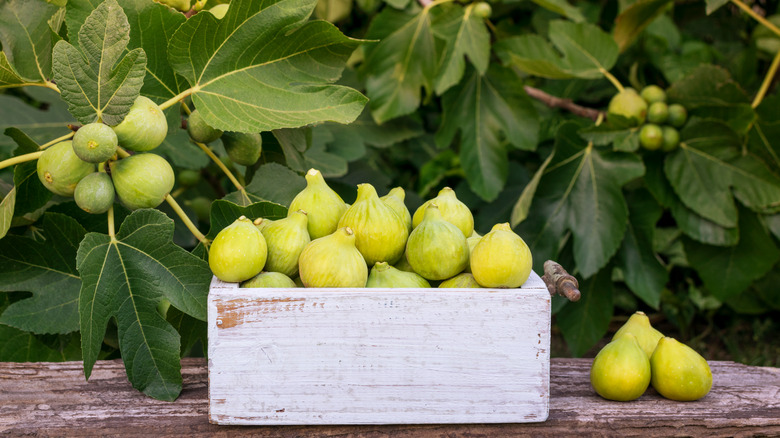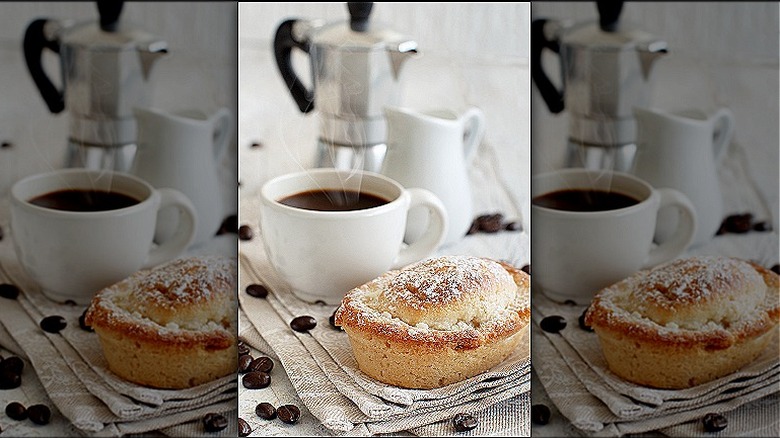14 Foods And Wines You Have To Try In Puglia, Italy
The best-kept gastronomic secret epicenter in Europe just might be Puglia, Italy. Resembling the heel of a boot, Puglia (or Apulia) juts into the Mediterranean Sea and is flanked by the Adriatic Sea to the east, the Gulf of Taranto to the west, and the Ionian Sea to the south. The rustic wilds of Italy's southeasternmost region are lush agricultural basins edged by miles of gleaming white beaches, basking in the searing Italian sun. With a balmy Mediterranean climate, mineral-rich soils, and cooling sea breezes, grape vines and olive trees thrive, producing nearly 40% of the nation's olive oil and succulent, perfumed wines (per Italy Magazine).
Known for its signature cucina povera (cuisine of poverty) marked by exceptionally fresh, local, and seasonal ingredients, Puglia is a slow food-purist haven. Given its location, Puglian cuisine is influenced by centuries of immigrants and occupants from Greece, Turkey, and North Africa, each bringing their flavors and techniques with them.
The next time you explore culinary Italy, consider Puglia. You won't be sorry. Puglia thrives on flourishing agrotourism and enotourism, and welcoming everyone from food and wine newbies to serious aficionados. Sipping and supping from Bari to Brindisi in the east, Taranto in the west, and Lecce in the south, Puglia will surprise you with its first-class accommodations, trattorias, and fine dining restaurants offering a modern and fresh approach to gastronomy as well as with causal traditional cuisine.
Pasta Orecchiette
Apulians are serious about their pasta and create hundreds of shapes (per "Lonely Planet Puglia & Basilicata"). Historically, pasta from Puglia and southern Italy is crafted from hard-grained durum wheat semolina flour, water, and salt. Semolina flour produces a thick and tough dough resulting in sturdy, chewy, and filling pasta. In days gone by, Pugliese women set up tables side by side in the streets and swiftly worked the dough by hand into regional shapes, drying the fresh pasta on open-air racks. These days, visitors congregate to watch nonnas (grandmothers) deftly mold stretches of dough into bite-sized shapes, each with its unique purpose and sauce.
Orecchiette (little ears) with broccoli rabe is a Puglian classic that is ubiquitous in the region. Orecchiette are hand-crafted by shaping bits of dough on one's thumb and slightly rolling the edges, resulting in a tiny bowl-shaped pasta. The little cups are perfect for holding fresh tomato sauces, or olive oil-scented with roasted garlic, herbs, and grated fresh Pecorino Romano cheese.
Primitivo wine
Wines from southern Italy differ from wines from central and northern Italy in body, flavor profile, style, and aromatics. Puglia is heavily planted with vines and nearly 80% are red grape varietals. According to Forbes, Puglia is the second largest organic wine region in Italy, and upwards of 90% of its wines are exported. The region has significantly warmer and drier climates than most of the Italian peninsula, resulting in potent, muscular wines with inky colors and robust flavors.
When it comes to brawny red wines, primitivo is at the top of the chart. MasterClass indicates that primitivo is native to Croatia and genetically identical to American zinfandel. Primitivo is a smoky, ripe, fruit-forward wine with low acidity, moderate tannins, and high alcohol. It can be high in residual sugars, noted in its baked and jammy fruit profile. Primitivo di Manduria DOCG is the most influential region in Puglia for great primitivo wines. It is in Manduria that primitivo expresses its most classic notes of blackberry, bramble, ripe black cherry, fresh dates, and earthy spices.
Taralli crackers
In a region famous for its durum wheat semolina flour and dozens of styles of bread, Puglia is famous for a tiny, ring-shaped cracker called taralli (or tarallini). Taralli crackers are everywhere in Puglia. Little baskets grace wine tasting room bars, stores, and trattoria across the region. Everyone nibbles on crunchy taralli.
According to Envoyer Fine Wines, the ubiquitous and popular little ring crackers are a cultural icon dating back to the 1400s. Legend has it that a clever nonna (grandmother) first crafted the little crackers by combining semolina flour, salt, olive oil, and a bit of water, creating a stiff dough that she shaped into little rings resembling tortellini. The dough is first boiled and then baked until crisp.
Because of its longevity and abundance, the taralli cracker was bestowed with Prodotto Agroalimentare Tradizionale (PAT) status, meaning that only Pulian taralli are genuine. All others are imitations. Modern iterations might be infused with fennel seeds, rosemary, garlic, or chili flakes, but the basic taralli is delicious unadorned. Taralli crackers are savory and perfect as a palate cleanser when tasting wine. Since it's not too bland or flavorful, the little cracker is the perfect reset when working your way through a flight of wines.
Burrata cheese
The Pugliese rear livestock — including cows, buffalo, goats, and sheep — for their milk to use in their flourishing cheese industry. During leaner times, the region was so poor that butchering a milk-producing animal was a waste of nourishment and commerce. As a result, the Pugliese learned to craft a variety of delicious cheeses ranging from soft, fresh burrata, mozzarella, stracciatella, caciocavallo, and cacioricotta, to aged hard cheeses like Pecorino. While Pecorino (a hard and salty sheep's milk cheese), is perfect for grating over pasta and soup, Apulian soft cheeses are the regional pride and joy.
Take buttery burrata. Burrata is a luscious little ball of heaven with its firm and glossy white exterior that oozes with cream once sliced open. It's actually a type of mozzarella infused with a creamy center. Fresh mozzarella curds are formed into a little bag and stuffed with cream and bits of cheese before being sealed shut. Burrata is best served as an appetizer with a drizzle of aromatic olive oil, freshly ground pepper, a sprig or two of basil, and a sprinkling of sea salt crystals. Spread burrata on focaccia, taralli crackers, or warm toast.
Negroamaro Salice Salintino DOP wine
Southern Italy experiences hot and dry summers with warm, rainy winters. Climate change is impacting agriculture in the region, most noticeable in its wine. Puglia is making a comeback from a commercial bulk wine industry to one focusing more on small producers, sustainable practices, traditional styles, and native grape varietals, hoping to stave off the worst impacts of a volatile climate. Native grapes, like negroamaro, are essential to the classic culture and survival of Apulian wine. MasterClass reports that the obscure negroamaro grape is native to southern Italy. The name means black and bitter, but its wines are surprisingly fruity, and lush, with a spicy backbone, and can be similar to a delicately aromatic syrah.
According to Wine Folly, negroamaro is produced in the Salice Salentino DOC and exudes ripe and fruity notes of plum, raspberries, and baking spices. Negroamaro tends to be a fleshy, full-bodied wine with restrained tannins and medium acidity. Look for red and rosé negroamaro wines. It isn't too serious making it a perfect pairing for prosciutto pizza, spicy Italian sausage cavatelli, and spaghetti and meatballs.
Pasta Cavatelli
Along with orecchiette, pasta cavatelli is an Apulian classic. The pasta looks like a tiny cap that has been folded down the center. Cavatelli is crafted from durum wheat semolina flour, water, and salt, just like orecchiette, and shaped similarly by hand before cooking or drying on open-air racks. Cavatelli is frequently found in other regions across Italy, including Sicily, and is an adaptable pasta that works well with many sauces and flavors because of its shape.
As with most Apulian cuisine, cavatelli is best with simple ingredients and a classic preparation includes fresh tomato, garlic, and arugula, drizzled with olive oil. Cavatelli is popular with wild mushrooms, meat sauce, and spiced pork sausage. Don't be afraid to get creative when preparing your own cavatelli. The pasta is a perfect addition to soups and can be sauced with a wide range of sauces from cream to tomato or meat and fish sauces.
Fava e cicorie
In a region known for its slow food, locavore approach to cuisine, it is no surprise that foraging is a mainstay for collecting ingredients. Wild fruits and vegetables like lampascioni (a wild onion that is considered a regional delicacy), cicorie (chicory greens), legumes, and greens like arugula, spinach, and chard are easily found in the wild. These days, gardens and farms are planted with rows and rows of regional vegetables. In a nod to its peasant roots, Apulian cuisine makes frequent use of these simple ingredients.
One popular dish for home cooks and trattoria chefs across Puglia is fave e cicorie, or fava beans with chicory. The simple mainstay consists of cooked chicory served alongside cooked and mashed fava beans. Chicory can be steamed, boiled, or sautéed with olive oil, aromatic herbs, and a splash of red or white wine. The classic dish earned the prestigious Prodotto Agroalimentare Tradizionale (PAT) status, highlighting its significance in Apulian cuisine.
Parmigiana di melanzani
Eggplant is tremendously popular across the Mediterranean coastline. It's a versatile, starchy vegetable with a delicate but distinctive flavor. Eggplant can be cubed and roasted (French ratatouille), sliced thin and baked, grilled and puréed into a spread (Greek melitzanosalata and Lebanese baba ghanoush), or added to soup. In Puglia, one popular eggplant dish is called parmigiana di melanzani, also known as eggplant parmesan.
Layers of sliced eggplant are drizzled with marinara and sprinkled with generous handfuls of shredded mozzarella cheese before being topped with spoonfuls of sauce and a hefty sprinkling of grated parmesan. Baked in a casserole dish or in individual-sized pots until browned and tender, parmigiana di melanzani is a hearty and satisfying starter or meal that is enjoyed across southern Italy, particularly in Puglia. Serve parmigiana di melanzani with crusty bread drizzled with olive oil and a green salad for an Apulianesque meal.
Gravino bianco wine
The vast majority of Puglian wines are red, but the region makes spectacular rosés, white, and dessert wines. According to Forbes, Puglia is known for its indigenous grapes including aromatic and floral white grapes; fiano, verdeca, bianco d'Alessano, malvasia del Chianti, and greco. A handful of Apulian sub-regions specialize in white wines, and the best come from Murge and Gravina. "Lonely Planet" suggests that white wines from the Locorotondo and Martina subregions of Murge are light-bodied, and Gravina white wines have more texture. Gravina DOC produces Gravina bianco and Gravina spumante (fizzy), both from 50% greco and at least 20% malvasia, the remaining blend can include fiano, chardonnay, verdeca, and bianco d'Alessano.
Apulian white wines tend to be food-friendly wines with bright aromatics, herbal notes, zesty citrus, and sharp salinity on the finish, making them absolutely perfect for Apulian cuisine, particularly when paired with fresh fish and seafood. The wine's tangy acidity plays well with local cheeses, like burrata, buffalo mozzarella, and sheep and goat milk cheese like Pecorino and cacioricotta.
Tarantello di tonno
With its proximity to the sea, Puglia is virtually a seafood paradise. The crystal blue waters of the Adriatic Sea, the Ionian Sea, the Gulf of Taranto, and the Mediterranean Sea are teeming with varieties of sardines, anchovies, mussels, lobster, prawn, tuna, swordfish, bream, monkfish, and cuttlefish. The region has hundreds of ways to prepare, cook, and preserve its fresh seafood and fish. Canning is just one popular method. Coveted the world over, Italian canned fish is considered to be among the best. The fish are bathed in fragrant olive oil and enhanced with aromatic regional herbs, elevating their flavors.
Perhaps the best canned fish comes from Taranto, along the western coast of the boot. The region adjacent to the Taranto Gulf and the city of Taranto have been trapping tuna for centuries. Using the fattiest meat from the belly of the fish, Taranto tuna is rich and flavorful. This tuna meat is used for tartare, carpaccio, and canning, but it's the classic Tarantello di tonno that is the regional signature. Tarantello di tonno is a specific preparation that resembles Italian sausage that dates back to the 1600s (per Made in Taranto). It can be made like tartare or cooked and is often a starter or light lunch.
Olive oil
According to Olive Oil Italy, Puglia produces between 40 and 50% of the nation's entire production. The vast (and relatively flat) agricultural region is studded with ancient olive tree groves interspersed between miles and miles of vineyards. The olive oil from Puglia is considered to be some of the best in the world and subregional oils are protected by Protected Designation of Origin status just like Italian wines. Olive oils with DOP certifications include those from Bari, Brindisi, Otranto, and Duano. Rich and fragrant, Apulian olive oils can have a floral, peppery flavor perfect for drizzling on salads, cheeses, and bread as a finishing oil.
Recently, Apulian olive trees have experienced a catastrophic crisis. A foreign bacteria was introduced to the region and it is decimating centuries-old olive trees and devastating olive oil production. More than 6.5 million trees were infected and subsequently destroyed in Puglia between the years 2012 and 2017, per Olive Oil Italy. Since there isn't a cure for this disease, Apulian olive oil is in danger, and the disease could easily spread across the entire Mediterranean, driving olive oil prices into the stratosphere while crippling an important gastronomic cultural icon.
Zuppa di pesce
With hundreds of miles of coastline (per Wine Tourism) Puglia is rich in seafood. Its fresh bivalves, fish, and shellfish are an abundant delicacy in Apulian cuisine. The Mediterranean is known for fish soup and stews such as French bouillabaisse, Spanish caldereta, Turkish ekşili balik, and Italian cioppino. In Puglia, zuppa di pesce (fish soup) and zuppa di pesce fuggito (fish soup made with shells and bones as flavoring) are delectable seasonal treats crafted from wild-caught and foraged ingredients, per "Lonely Planet Puglia & Basilicata."
Puglia.com suggests seasonally available fish for traditional ciambotto (zuppa di pesce) including small fish such as cuttlefish, but modern recipes can include monkfish, cod, bream, octopus, mussels, and prawns. Zuppa di pesce is enhanced with cherry tomatoes, parsley, garlic, red pepper flakes, and a hefty splash of dry white wine. Some Apulian chefs add a few saffron threads to deepen the flavor of the soup.
Figs
Figs trees produce plump inverted flowers that are eaten like a fruit that are found in Asia, the Middle East, North Africa, and throughout the Mediterranean. Figs have been a symbol of fertility and wealth since ancient times and were used as an aphrodisiac and masculine virility-enhancing food by Greeks, Romans, and Egyptians, per "The Magic of Food." Figs are grown across Puglia. They're nutritious and delicious whether fresh or dried, and make for a sweet snack or addition to sweet and savory recipes.
Fresh figs are greenish to purple and delicate little bundles of fleshy sweet goodness that perish rapidly. It is best to eat them promptly or use them to make jams or preserves. Fresh figs are fantastic alongside savory prosciutto, charcuterie, and cheese boards. The majority of figs are dried to preserve flavors and the longevity of the flower. Dried figs can be eaten whole or diced and added to recipes like stuffing, chutney, cakes, cookies, and fruit breads.
Pasticciotto
No trip to Italy would be complete without sampling its incredible pastry. Puglia boasts hundreds of delectable confections like fichi mandorlati, sfogliatelle di Canosa, torta colonne, barchiglia, and occhi di Santa Lucia, using finely ground flours, almonds, honey, chocolate, lemons, cherries, pistachios, and walnuts, as enticing ingredients. But no pastry is more popular than the simple little oval cake called pasticciotto.
Pasticciotto have a rich history, and the modern version are small shortcrust cakes filled with delicate lemon-scented cream. Italians take a light breakfast of hot coffee with steamed milk (cappuccino) alongside a small pastry. In Puglia, pasticciotto is a traditional breakfast pastry. Buttery rather than sweet, the pasticciotto are perfect with robust espresso or cappuccino, but also work well as an after-dinner dessert. Regional variations are available, with some filled or topped with jams or preserves. But the original cream-filled pasticciotto is a classic treat worth trying wherever in Puglia you may be.
